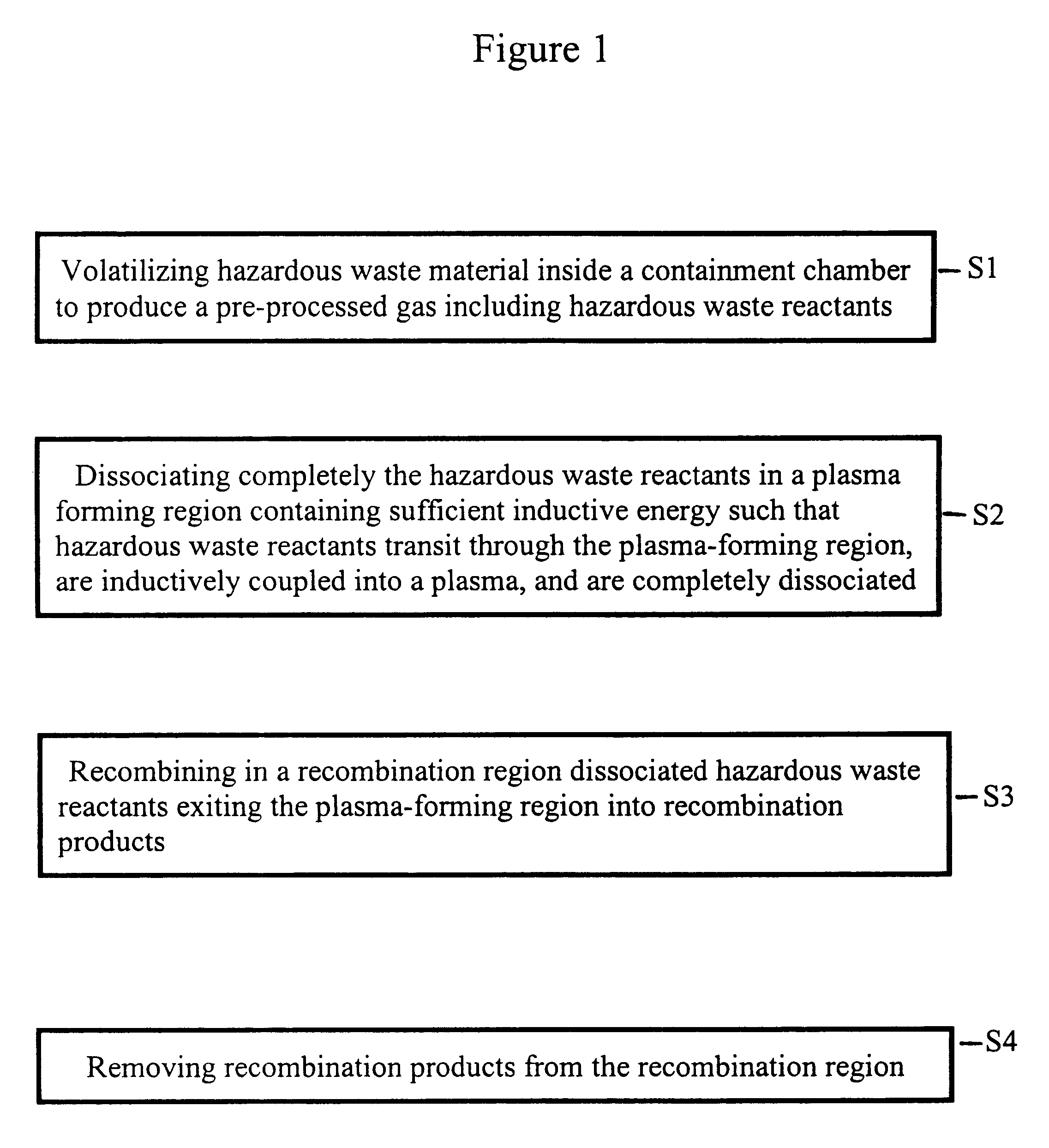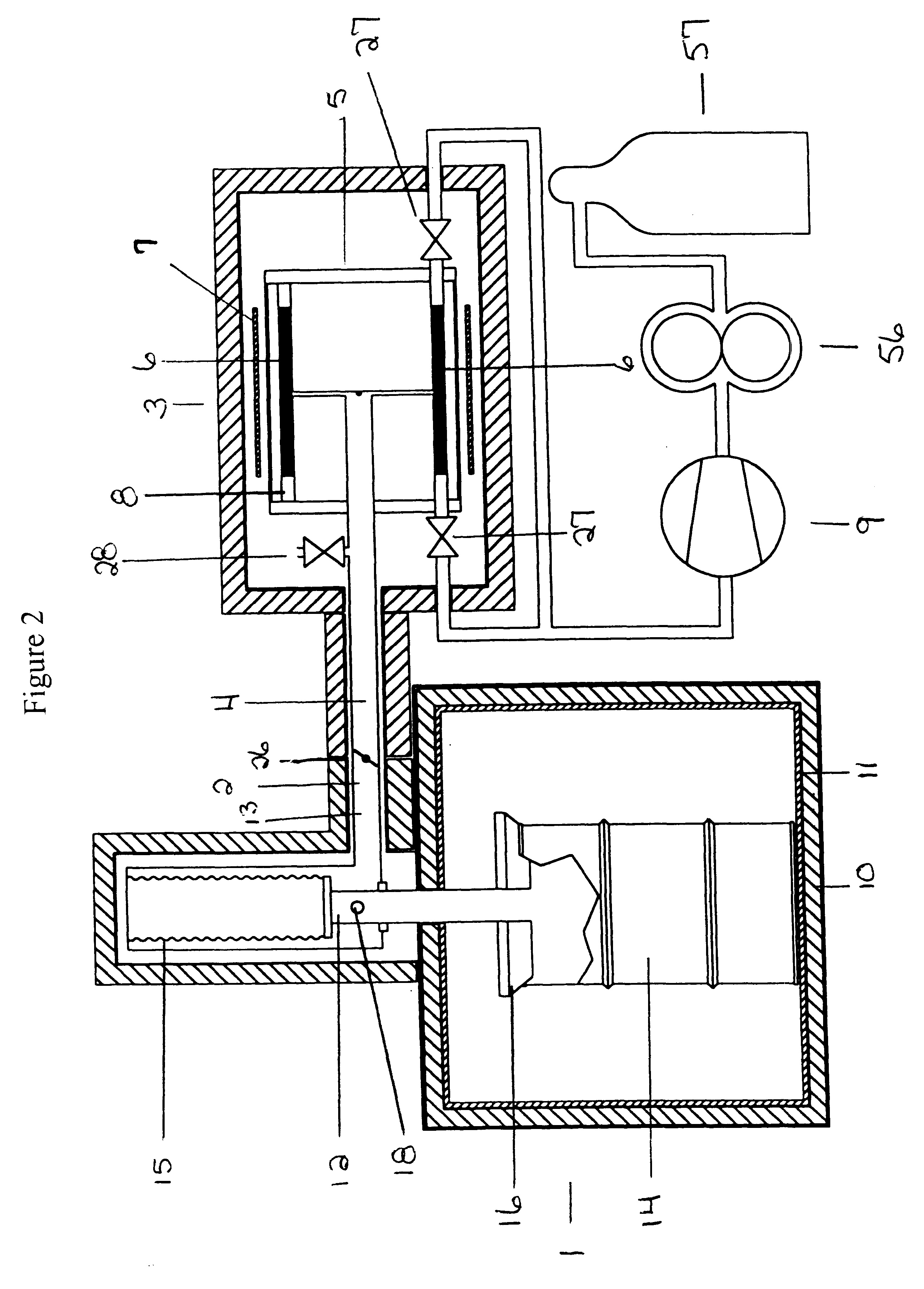Given that many of neurological bio-hazards, such as
sarin are in liquid form, this presents significant complication.
For example, processes which might be used on
solid waste such as simple closed containment heating to 540.degree. C., if used will create extreme pressures.
This
scenario presents an unacceptable risk to the environment and personnel at disposal sites.
In addition, the articles packed in the drums have a variety of shapes and compositions which presents gas stratification problems with different components volatilizing in the drum at different depths in the drum.
Unfortunately,
incineration techniques produce considerable exhaust to the
atmosphere which poses significant safety concerns given that 100% destruction of the hazardous nerve gas agents may not be certain.
This redundancy adds to the cost of the facility and its operation.
Despite the remote location, the
incineration facility still attracts a significant amount of public scrutiny and watch-dogging.
In addition, it is politically unacceptable to permit shipment of loads of nerve gas agents across the country to central disposal facilities.
Furthermore, establishing
incineration systems at a multitude of storage sites (many which are closer to larger
population concentrations) is financially and politically unacceptable.
Accidental discoveries of
chemical waste material by the public have demonstrated the seriousness of the buried weapons problem.
The concentrations of sarin in these drums vary significantly from one drum to another, and in addition many drums are contaminated with water.
While these approaches have been shown to be effective in converting toxic agents, they too suffer with similar problems to the
combustion processes.
Unfortunately, the low
power level limits the quantity of hazardous waste products which can be converted on a
single pass.
One can see from the calculation that low-power, glow-
discharge plasma systems typically 100-3000 W are limited in the quantity of nerve gas agent which can be
throughput.
Input power to
glow discharge systems can not be raised to high power levels.
Continued operation in this mode significantly degrades the
electrode material.
However, this approach suffers from severe plasma non-uniformities.
Thus, gas bypass becomes a serious concern and must be handled by re-circulation or a series of
microwave plasma processing stations.
Likewise, arc plasma torches and rf induction plasmas which have the requisite power dissipation to
handle significant amounts of nerve gas agent have arc and toroidal plasma sources, respectively, which
pose problems for complete introduction of gas into the plasma arc or toroid.
At these pressures, the gasses which are superheated by the arc or toroidal plasma source have enough
heat capacity that contact of these hot gasses with the chamber walls will result in wall failure and loss of containment.
Unfortunately, these sheath gas
stream paths represent gas paths by which sarin and other nerve gas agents can circumvent the plasma and not be thoroughly reacted.
Thus, two constraints have limited the development of plasma based tools for chemical and
biological waste disposal.
Glow discharge plasma systems which have diffuse uniform plasmas operate at low power and power densities and consequently suffer from incomplete reactant conversion, as every bond broken in the
gas phase requires a requisite number of joules to dissociate for disocaition.
Furthermore,
glow discharge plasma systems have inherent limitations related to self bias which prevent operating at
higher power levels.
On the other hand, arc-torches,
microwave plasmas, and rf plasma torches which operate with high power and power densities capable of
processing significant quantities of nerve gas agent have non-uniform plasmas in which the plasma is segregated into compact shapes which occupy only a fraction of the chamber volume and gas flow path.
Problems of incomplete conversion and
system blow-by require
system redundancies and recycling to maintain adequate safety precautions.
These solutions add considerable cost and complexity to the facility and operational cost.
Better plasma
waste disposal systems are needed especially in applications involving extremely toxic nerve gas agents where
system failures can lead to potentially catastrophic releases of nerve gas agent into the surrounding environment.
The presence of gas by-pass paths and comers in the Robson et al.
plasma chamber design severely restricts the amount of a reactant gas which can be
throughput without detection of the reactant gas in an output gas
stream from the rf induction tool.
Otherwise, the liquid source would freeze due to evaporative cooling.
This variety of objects at different depths presents stratification problems should the
effluent be simply pumped from the top of the storage container.
Electrons which diffuse to the walls typically recombine with ions there and are lost from the process.
The presence of by-pass paths severely restricts the amount of reactant gas which can be processed without detection of hazardous waste reactants downstream from the plasma finance.
 Login to View More
Login to View More 


